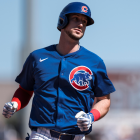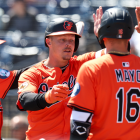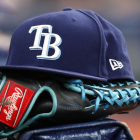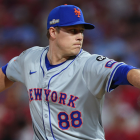On May 22nd, a little more than one month ago, the Astros lost their fourth straight game to fall to 17-28 on the season. They had just been swept by the division rival Rangers at home. Houston was in last place and 10 games back of the AL West lead. They were 8 1/2 games back of the second Wild Card spot.
Since that day, the Astros have been one of the hottest teams in baseball. They've gone 22-9 in their last 31 games to climb into second place in the AL West. The 'Stros are still 10 games back of the red hot Rangers, though they've cut their deficit to only 1 1/2 games for a Wild Card spot. They've picked up a lot of ground in a relatively short amount of time.
Houston's postseason odds, per FanGraphs, went from 68.0 percent on Opening Day to a season-low 18.4 percent on May 23rd. They've since rebounded to 45.8 percent. Here's the day-by-day playoff odds graph:
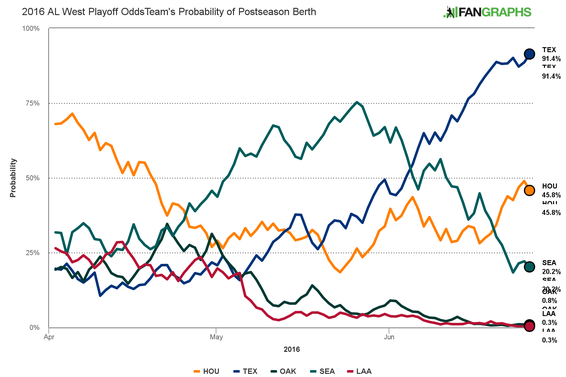
A lot has to happen for a team to turn its season around this drastically in about a month's time. That is certainly the case for these Astros. Here are five reasons Houston has been able to right the ship and climb back into the postseason race.
1. Valbuena and Gomez are hitting again.
Early in the season the Astros had a four-man lineup. They relied on Jose Altuve, George Springer, Carlos Correa, and Colby Rasmus to create runs because no one else in the lineup was doing much of anything. It's tough to win when less than half your lineup is clicking.
Luis Valbuena, who hit 25 home runs with a 105 OPS+ last season, started the 2016 season terribly, with a .174/.296/.232 batting line in his first 24 games. He didn't hit his first home run until the team's 31st game. Since that homer, Valbuena's been a monster at the plate.
| PA | AVG/OBP/SLG | 2B | HR | RBI | |
| First 24 games | 83 | .174/.296/.232 | 4 | 0 | 4 |
| Last 42 games | 161 | .293/.381/.536 | 10 | 8 | 21 |
Valbuena now has an 114 OPS+ on the season, better than what he did last year.
Furthermore, Carlos Gomez has started to hit too. His lack of production, especially earlier this season, was no secret. The Astros and Gomez were being ripped for last summer's trade and his total lack of impact.
Gomez carried a .181/.249/.297 batting line into the team's 66th game of the season on June 14. That's not that long ago! Gomez then went 2 for 4 that night, 2 for 3 the next night, and 3 for 5 the night after that. He's gone 15 for 41 (.366) in his last 11 games, and while that's not much of a sample at all, it's a heck of a lot better than what Gomez was doing earlier this season.
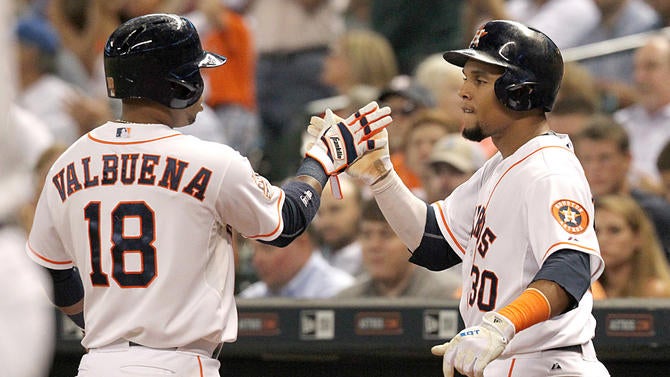
Not coincidentally, Gomez's hot streak has coincided almost perfectly with his return from the DL. (He missed a few weeks with a bruised rib cage.) A healthy player is more productive than an injured player? Well I'll be. Gomez is not all the way out of the woods yet, but the Astros are getting something out of him now rather than nothing.
2. McCullers returned from the DL.
Last season Lance McCullers Jr. was called up in mid May to give the rotation a real shot in the arm. He pitched to a 3.22 ERA (122 ERA+) in 125 2/3 innings after joining the Astros, then allowed two runs in 6 1/3 innings in his lone ALDS start.
This season McCullers returned from the DL in mid May, and he's again given the rotation a nice shot in the arm. So far this season McCullers has a 3.91 ERA (107 ERA+) in eight starts and 46 innings. His power stuff is a much different look than the rest of the rotation, which is filled with finesse pitchers.
Before McCullers returned, the Astros were using veteran Scott Feldman and rookie Chris Devenski as their fifth starter. The duo combined for 4.81 ERA and a 1.68 WHIP in eight starts and 39 1/3 innings. McCullers has been a huge upgrade.
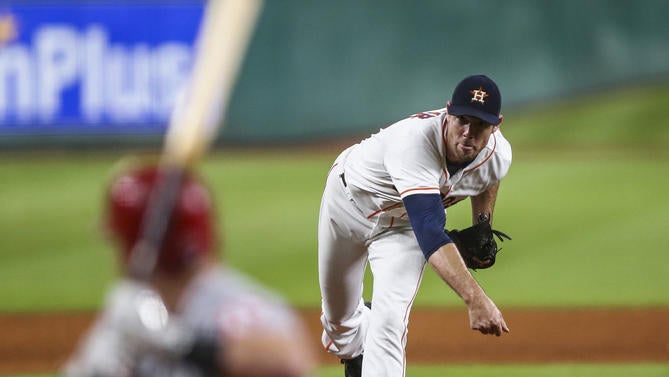
3. Fister has regained his pre-2015 form.
The Astros signed two free agents this past offseason. They re-signed lefty setup man Tony Sipp, giving him a three-year deal worth $18 million. They also signed veteran right-hander Doug Fister, who was coming off a poor season with the Nationals, one that saw him demoted to the bullpen. Houston gave Fister a one-year "prove yourself" contract worth $7 million.
In April, it looked like the Astros were getting the 2015 version of Fister, the guy who pitched himself out of the rotation. He had a 5.56 ERA in four starts and 22 2/3 innings May, and opponents were hitting .264/.347/.517 against him with as many walks (11) as strikeouts (11). Fister's not a hard-thrower. He needs to be fine to succeed, and his location wasn't good in April.
Since the calendar flipped to May, Fister has resembled the guy who quietly ranked 10th among all pitchers with +17.1 WAR from 2011-14. He has a 2.38 ERA in his last 10 starts -- all quality starts, by the way -- and 64 1/3 innings, and opponents are hitting only .223/.283/.353 against him. His strikeout (44) and walk (17) numbers are much better too.
How has he done it? By changing his position on the rubber. Fister told Brian T. Smith of the Houston Chronicle shifting towards the first base side of the mound gives him a better angle for his sinker, and helps everything else play up. "That has changed my game plan (because) I can throw a curveball off of that. I can go back down and throw a sinker. The opportunities opened back up again for me," he said.
Here's a look at Fister's horizontal release point from 2013-15, per Brooks Baseball:
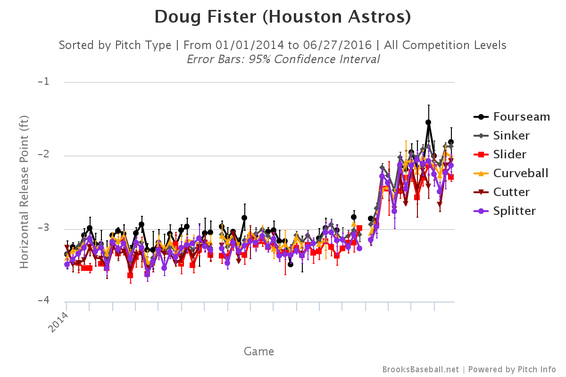
In 2013 and 2014, Fister was consistently releasing the ball roughly 3.4 feet from the center of the pitching rubber. He's a right-hander, so that 3.4 feet is towards the third base side. This year he's gradually moved closer to first base, so his release point is only 2.0 feet from the middle of the rubber.
That difference of 1.4 feet (give or take) changes everything. It changes the angles on all of Fister's pitches to both righties and lefties. He's made that subtle adjustment and it's helped him get back to being one of the better pitchers in all of baseball.
4. Giles is starting to look more like a dominant reliever.
The biggest move the Astros made over the winter was trading a big package of young players to the Phillies for ace setup man Ken Giles. Giles was one of the best relievers in baseball from 2014-15, but his first month in Houston could not have gone worse. He had a 9.00 ERA and a 2.00 WHIP in 10 innings. Giles also allowed four homers, one more than he allowed in two years with Philadelphia.
Manager A.J. Hinch had no choice but to move Giles into a lower leverage middle relief role, and in that role, Giles is starting to get back to what make his so successful from 2014-15. He has a 2.95 ERA with 24 strikeouts in 18 1/3 innings in his last 20 appearances. Giles did blow a two-run lead last weekend, though meltdowns like that are happening much less frequently.
By no means is Giles all the way back to where he was in previous years and where the Astros want him, but at least now he's trending in the right direction. He lost Hinch's trust in a hurry -- how could he not? -- and is now starting to earn it back. The Astros need Giles to dominant out of the bullpen and he's starting to do that again.
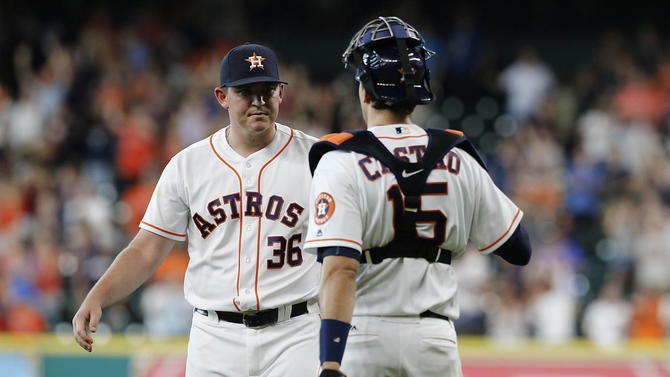
5. They made a change at closer.
When the season started and the Astros announced Luke Gregerson would remain the closer, most figured it was only a matter of time until someone else handled ninth inning work. Everyone expected that someone to be Giles, but as it turns out, Will Harris has gotten the call.
Gregerson blew three of his first 11 save chances and five of his first 18 save chances, at which point Harris took over. Harris has gone 6 for 6 in save chances and has allowed only three runs in 32 2/3 total innings this season. He's brought stability to the ninth inning and allowed Gregerson (and Giles) to take a step back and assume less responsibility for the time being.
The Astros dug themselves a very real hole earlier this season, one they're still trying to climb out of. They're getting closer to the race but still have more ground to make up. An improved lineup (Valbuena, Gomez) and an improved rotation (McCullers, Fister) have helped key this turn around, but don't sleep on the bullpen changes either.
![[object Object] Logo](https://sportshub.cbsistatic.com/i/2020/04/22/e9ceb731-8b3f-4c60-98fe-090ab66a2997/screen-shot-2020-04-22-at-11-04-56-am.png)









